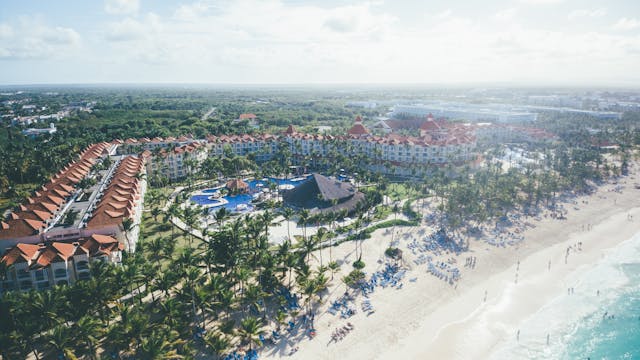
Caribbean Real Estate ROI Myths Part 2

There are a lot of factors that pull investors into purchasing Caribbean real estate and today we are going to examine the nitty gritty of some details that might get left out of the purchasing process, and cause you to suffer less than ideal returns.
One of the topics that will addressed in this new blog is how to navigate condo purchases in an Unregulated Caribbean Real Estate Market and the hidden costs and challenges. In an unregulated Caribbean Real Estate market things can be much like a giant “free-for-all”. No regulating body, no license, every person out for themselves. Needless to say you will be conducting lots of due diligence.
Let’s dive in!

This blog is a continuation of Caribbean Real Estate ROI Myths.
Condo VS Hotel
How do you know if real estate agents are overpromising the daily rental rates potential investors could secure? Where do brokers/agents get their Caribbean real estate comparables, or “comps” from?
Comparing condos to hotels isn’t the best idea, yes, they are similar but not quite the same. It’s still an apples to oranges comparison.
In an unregulated Caribbean Real Estate market you can very well end up with a situation where the forecasted income and occupancy rates are overstated and the management expenses/projected ROI are understated. You don’t want to end up with a Caribbean Real Estate asset that produces very little NOI and doesn’t appreciate in value. The brokers/agents that are selling these projects are relying on hotel statistics, which is not the best or even an accurate comparison.
How do you know the agents aren’t overselling the income the buyers will make?
Riviera Maya Mid-Year 2024 Insights Here
Punta Cana Mid-Year 2024 Insights Here
Real estate agents should avoid comparing hotel stats to condo stats for several reasons, primarily due to the fundamental differences in the nature, usage, and market dynamics of these two types of properties. Here are some key reasons:
1. Purpose and Usage
- Hotels: These are primarily used for short-term stays by travelers and tourists. The revenue model is based on nightly rates and high turnover.
- Condos: These are residential Caribbean Real Estate properties typically owned by individuals or entities. They are often used for long-term living, either by the owners or as rental properties for tenants. Most of the time the tenants are staying more than 2 nights.
2. Revenue Models
- Hotels: Revenue is generated through nightly rates, and occupancy rates can fluctuate greatly depending on seasons, events, and market conditions.
- Condos: Revenue (if rented) is usually derived from monthly rents, and occupancy rates tend to be more stable, reflecting longer-term leases.
3. Investment Considerations
- Hotels: Investors consider metrics like average daily rate (ADR), revenue per available room (RevPAR), and occupancy rates.
- Condos: Investors look at rental yield, capital appreciation, homeowner association (HOA) fees, and overall market conditions for residential properties.
4. Market Dynamics
- Hotels: Market dynamics can be heavily influenced by tourism trends, business travel, and local events. The performance of hotels is often tied to the broader travel industry.
- Condos: The market for condos is more influenced by local housing market conditions, interest rates, employment rates, and general economic health.
5. Regulatory Environment
- Hotels: Often subject to different regulations and zoning laws compared to residential properties. They may also face different tax treatments.
- Condos: Governed by residential property laws and regulations, including tenant rights and HOA rules.
6. Maintenance and Management
- Hotels: Require constant management and maintenance due to the high turnover and need to maintain a certain standard of service and amenities.
- Condos: Typically require less frequent but still regular maintenance, with management often handled by the owners or a property management company.
7. Market Metrics
- Hotels: Metrics such as occupancy rates, ADR, and RevPAR are specific to the hospitality industry.
- Condos: Metrics like price per square foot, rental yield, and appreciation rates are relevant for residential properties.
A Great Breakdown of Punta Cana Tourism Numbers
Comparing hotel stats to condo stats can lead to inaccurate conclusions and misguided decisions due to the inherent differences in their usage, revenue models, market dynamics, and investment considerations. Real estate agents should instead compare properties within the same category to provide relevant and accurate analysis.
The Scoop on Amenities
Are the amenities are overrun with people? Did the developer build a property specific amenity, aka an “aspirational amenity”, that takes up space and will cost the condo owners a higher monthly amount to upkeep? Is there a regular flow of guests and residents that use the amenity?
Property-specific amenities in condo real estate can present several challenges for both buyers and developers. These challenges can impact marketability, value perception, and the overall management of the property. Here are some key problems associated with property-specific amenities in condo real estate:
1. High Maintenance Costs
- Upkeep: Amenities such as swimming pools, gyms, or private theaters require regular maintenance, which can be costly. The expense for maintaining these amenities is typically shared among all condo owners through homeowners association (HOA) fees.
- Specialized Equipment: Certain amenities might require specialized equipment or services, increasing the complexity and cost of maintenance.
2. Increased HOA Fees
- Financial Burden: High-maintenance amenities can lead to increased HOA fees, which can be a financial burden for residents. Prospective buyers may be deterred by these higher fees.
- Budget Constraints: High fees can also strain the HOA’s budget, potentially leading to deferred maintenance or the inability to fund other necessary projects.
3. Differing Resident Preferences
- Utilization Rates: Not all residents may use all the amenities, leading to dissatisfaction among those who feel they are paying for features they don’t use.
- Demographic Differences: Diverse resident demographics can result in varying preferences for amenities. For instance, families with children might value playgrounds and pools, while young professionals might prefer gyms and co-working spaces.
4. Impact on Property Value
- Perceived Value: While some amenities can enhance property value, others may not be as appealing to all buyers. Over-investment in certain amenities that don’t have broad appeal can negatively impact resale values.
- Marketability: Condos with amenities that are too niche or specific may struggle to appeal to a broader market, limiting the pool of potential buyers.
5. Space Utilization
- Limited Space: Condos have limited space, and dedicating significant areas to amenities can reduce the overall living space or green areas available to residents.
- Versatility: Some amenities may not be versatile enough to be repurposed if resident preferences change over time, leading to underutilized or obsolete spaces.
6. Regulatory and Liability Issues
- Compliance: Certain amenities might require compliance with specific regulations, which can be costly and complex to manage.
- Liability: Amenities like pools and gyms can pose liability risks. Ensuring safety and managing potential liability can be challenging and expensive.
7. Management Complexity
- Operational Challenges: Managing amenities effectively requires operational expertise, which can be demanding for the HOA or property management team.
- Quality Control: Maintaining high standards for all amenities can be difficult, particularly as the property ages and wear and tear become more evident.
While amenities can enhance the appeal and value of a condo property, they also come with significant challenges that must be carefully considered. Balancing the benefits of amenities with their associated costs, management complexities, and resident preferences is crucial for developers and condo associations to ensure long-term satisfaction and financial stability.

If you have access to the financial statements of the HOA or the condo you are looking to purchase, this is a plus. Is the condo that you want to purchase netting positive cash flow? Are other condos in the building netting positive cash flow as well?
Navigating Condo Amenities in an Unregulated Market: Hidden Costs and Challenges
So what happens when a multitude of projects are completed and each unit is handed over to the owners? Now there is a surge of open units hitting the market and the affects the price of of each unit and the bottom line of the investor.
Upon the completion of multiple condo buildings in a close proximity, the significant rise in supply may exert downward pressure on rental rates, adversely affecting the financial returns for investors. According to brokers and developers, the success of these projects will depend on factors such as location, design, pricing strategy, and management.
There are an upwards of 300+ Caribbean Real Estate projects that are currently being built in Tulum.
When several condo buildings open up in close proximity, investors might face several issues, including:
Market Saturation:
- Oversupply: An influx of new condos can lead to an oversupply in the market, which can depress prices and rental rates.
- Increased Competition: More condos mean more competition for buyers and renters, making it harder to sell or rent out units.
Price Pressure:
- Decreased Property Values: With many options available, the price of each individual unit may decrease as developers and owners compete for buyers.
- Lower Rental Yields: More available rental units can lead to lower rental prices, reducing potential income for investors.
Demand Uncertainty:
- Fluctuating Demand: If demand doesn’t keep pace with the increased supply, investors may face longer vacancy periods.
- Market Volatility: The local real estate market can become more volatile, making it harder to predict future trends and returns.
Amenities and Infrastructure Strain:
- Overburdened Services: The influx of residents can strain local amenities and infrastructure, such as public transportation, schools, and healthcare, potentially reducing the area’s attractiveness.
- Quality of Life: Increased density can lead to congestion and noise, which might deter potential buyers or renters.
Financing and Valuation Challenges:
- Appraisal Issues: If prices drop, it can affect appraisals and the ability to secure financing, as lenders might perceive higher risk.
- Loan Terms: Investors might face stricter loan terms or higher interest rates if the market is perceived as risky.
Regulatory Risks:
- Zoning Changes: Rapid development might lead to changes in zoning laws or building codes that could impact future development or profitability.
- Tax Implications: Increased development might result in higher property taxes or special assessments to fund infrastructure improvements.
Reputation and Branding:
- Homogeneity: Too many similar buildings can create a perception of homogeneity, making it harder to differentiate individual properties.
- Perceived Value: If new developments are perceived as lower quality or flood the market, it can impact the perceived value of existing units.
Long-Term Planning:
- Exit Strategy: The presence of numerous similar units can complicate exit strategies, as investors may struggle to find buyers in a saturated market.
- Market Shifts: Long-term changes in demographics or economic conditions might impact the desirability of the area.
Maintenance and Management:
- Increased Maintenance Costs: More buildings can lead to higher maintenance costs and potential issues with property management.
- Management Challenges: Managing multiple properties in close proximity can lead to logistical challenges and increased operational complexity.
Investors need to carefully consider these factors in Caribbean Real Estate and conduct thorough market analysis before investing in an area with multiple new condo developments. Diversifying your Caribbean Real Estate investments and staying informed about local market trends can help mitigate some of these risks.
In closing, Caribbean real estate can be a crazy place if you don’t know the right questions to ask or what to be on the look out for. We are here to help you. We hope you got some value from this blog, feel free to share and reach out if you have any questions about Caribbean real estate.
